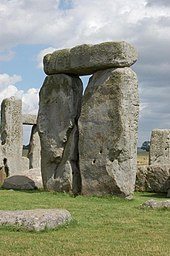Megalithic architectural elements
This article includes a list of generalreferences,butit lacks sufficient correspondinginline citations.(June 2017) |
This article describes several characteristicarchitectural elementstypical of Europeanmegalithic(Stone Age) structures.
Forecourt[edit]
Inarchaeology,a forecourt is the name given to the area in front of certain types ofchamber tomb.Forecourts were probably the venue forritualpractices connected with the burial and commemoration of the dead in the past societies that built these types oftombs.
In Europeanmegalithicarchitecture, forecourts are curved in plan with the entrance to the tomb at the apex of the open semicircle enclosure that the forecourt creates. The sides were built up by either large upright stones or walls of smaller stones laid atop one another.
Some also had paved floors and some hadblocking stoneserected in front of them to seal the tomb such as atWest Kennet Long Barrow.Their shape, which suggests an attempt to focus attention on the tomb itself may mean that they were used ceremonially as a kind of open air auditorium during ceremonies. Excavation within some forecourts has recovered animalbone,potteryand evidence of burning suggesting that they served as locations forvotiveofferings or feasting dedicated to thedead.
Kerb or peristalith[edit]
- Seecurb (road)for theroadsideedge.

Inarchaeology,kerb or peristalith is the name for a stone ring built to enclose and sometimesrevetthecairnorbarrowbuilt over a chamber tomb.
Europeandolmens,especiallyhunebedanddyssburials, often provide examples of the use of kerbs inmegalithicarchitecture but they were also added to other kinds of chamber tomb. Kerbs may be built in adry stone wallmethod employing small blocks or more commonly using larger stones set in the ground. When larger stones are employed, peristalith is the term more properly used. Often, when the earth barrow has been weathered away, the surviving kerb can give the impression of being astone circlealthough these monuments date from considerably later. Excavation of barrows without stone rings such as Fussell's Lodge inWiltshiresuggests that, in these examples, timber or turf was used to define a kerb instead.
In theBritish Isles,the enclosing nature of kerbs has been suggested to be analogous to laterNeolithicandBronze Agestone andtimber circlesandhengeswhich also demonstrate an attempt to demarcate a distinct,roundarea forritualorfunerarypurposes. Famous sites with kerbs includeNewgrangewhere many of the stones are etched withmegalithic art.An example of the dry stone wall type of kerb can be seen atParc le BreosinWales.
Orthostat[edit]
An orthostat is a large stone with a more or less slab-like shape that has been artificially set upright (so a cube-shaped block is not an orthostat).Menhirsand otherstanding stonesare technically orthostats although the term is used byarchaeologistsonly to describe individual prehistoric stones that constitute part of larger structures. Common examples include the walls ofchamber tombsand othermegalithicmonuments, and the vertical elements of the trilithons atStonehenge.Especially later, orthostats may be carved with decoration inrelief,a common feature ofHittite architectureandAssyrian sculptureamong other styles. In the latter case, orthostats are large thin slabs ofgypsumneatly and carefully formed, for use as a wall-facing secured by metal fixings and carrying reliefs, which were then painted.
Many orthostats were a focus formegalithic art,as atKnowthin Ireland.
Port-hole slab[edit]
Inmegalithicarchaeologya port-hole slab is the name of an orthostat with a hole in it sometimes found forming the entrance to a chamber tomb. The hole is usually circular but square examples or those made from two adjoining slabs each with a notch cut in it are known. They are common in thegallery gravesof theSeine-Oise-Marne culture.
Portal stones[edit]
Portal stones are a pair of Megalithic orthostats, usually flanking the entrance to achamber tombor opposite the axial stone of anaxial stone circle.They are commonly found indolmens.Examples may be seen atBohonaghandKnocknakilla.

Trilithon[edit]
A trilithon (or trilith) is a structure consisting of two large vertical stones supporting a third stone set horizontally across the top. Commonly used in the context ofmegalithicmonuments, the most famous trilithons are those atStonehengeand those found in theMegalithic Temples of Malta.
The wordtrilithonis derived from theGreek'having three stones' (Tri-three,lithos-stone) and was first used byWilliam Stukeley.The term also describes the groups of three stones in the Hunebed tombs of the Netherlands and the three massive stones forming part of the wall of theTemple of JupiteratBaalbek,Lebanon.[1]
See also[edit]
References[edit]
- ^Adam, Jean-Pierre (1977), "À propos du trilithon de Baalbek: Le transport et la mise en oeuvre des mégalithes",Syria,54(1/2): 31–63 (50f.),doi:10.3406/syria.1977.6623
Further reading[edit]
- James Phillips, theMegalithic Architecture in Europeseries
- Salvatore Piccolo (2013),Ancient Stones: the Prehistoric Dolmens in Sicily,Thornham/Norfolk (UK), Brazen Head Publishing

